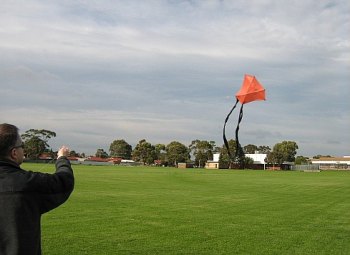- Home Page
- How To Fly
- Hand Launching
Hand Launching Kites
In Gusty Inland Winds
Do you want to know all about hand launching kites when the wind is gusty and the kite doesn't stay up long enough for you to let some line out? Let's assume the towing point is about right, since the kite tries to fly some of the time.
The best approach here is probably to just let a helper carry the kite some distance away while you let out the line. Then tell them to hold the kite up and let it fly out of their hand when the next gust comes through. If the helper is a kid, then just be prepared for them to hold the thing upside down though! Yes, it's happened more than once to us. Not all kids know how to fly a kite.
Eventually, with some practice, you will be able to get good at hand launches. You dangle the kite from your hand, let the wind catch it, and then let line slip through your fingers whenever you feel the kite pulling. If you do it right, the kite quickly gets higher.
Hand launching kites is a balance. Let line out too slow, and the kite is still low down when the wind dies. Let it out too quick, and the kite loses height, perhaps all the way to the ground! Climbing a kite is a process of letting out line when the tension is strong and holding on when the tension is light.
I had plenty of practice hand launching while developing a series of kite designs that used bamboo BBQ skewers for spar material. For example, there was the 2-Skewer Barn Door featured in the photo further down.
On this site, there's more kite-making info than you can poke a stick at. :-)
Want to know the most convenient way of using it all?
The Big MBK E-book Bundle is a collection of downloads—printable PDF files which provide step-by-step instructions for many kites large and small.
Every kite in every MBK series.
 MBK 2-Skewer Barn Door
MBK 2-Skewer Barn DoorA tip: Unless your spool or winder is designed to let out line continuously, it is easier to just pull off a fair amount of line onto the ground before attempting to get the kite flying. It's easy to slip line through your fingers when you don't have to try and unwind it at the same time!
When the tension is very light, you might even have to give the kite a hand by pulling line back in! This can be a lot of fun, when trying to keep a kite up in wind that is barely strong enough to make it fly. I can recall several times when I have brought the kite almost all the way back to my hand before managing to climb it away again up to several hundred feet in the air. When you can do this well, you'll feel like an expert!
Another tip:
Whenever you need to lay line on the ground, try to move around a bit so it doesn't pile up in one spot. Knowing how to fly a kite includes avoiding nasty tangles!
As mentioned earlier, there's more kite making on this site than you can poke a stick at. :-)
Want to know the most convenient way of using it all?
The Big MBK E-book Bundle is a collection of downloads—printable PDF files that provide step-by-step instructions for many kites large and small.
That's every kite in every MBK series.
